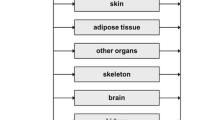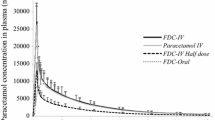Abstract
The plasma protein binding and competitive inhibition parameters of R(−)- and S(+)-ibuprofen were determined in vivo in 12 healthy subjects. Subjects participated in a 4×4 Latin square design in which oral solutions of drug were administered as 300 mg R (−)-ibuprofen, 300 mg S (+)-ibuprofen, 300 mg R (−)-+300 mg S (+)-ibuprofen, and 300 mg R(−)-+600 mg S (+)-ibuprofen. Unlabeled ibuprofen enantiomers were quantitated using a stereospecific reversed-phase HPLC assay, and plasma protein binding experiments were performed using radiolabeled14C-enantiomers and an ultrafiltration method at 37C. At therapeutic drug concentrations, the protein binding of each enantiomer was greater than 99%. Furthermore, the binding of ibuprofen enantiomers was Stereoselective and mutually competitive, as well as nonlinear. The bound-free data were fitted to a model in which the non-linearity of plasma protein binding and competition between enantiomers for binding sites could be accommodated. There were substantial differences in the affinity of ibuprofen enantiomers for protein binding sites (RP2=0.358±0.185 vs. SP2=0.979 ±0.501 μg/ml; X±SD) but no differences in their binding capacity (RP1=160±86 vs. SP1=161 ±63 μg/ml). Although statistically significant, the differences in competitive inhibition parameters were more modest (SKI=0.661 ±0.363 vs. RKI=0.436 ±0.210 μg/ml). As a result, the intrinsic binding (i.e.), P1/P2J of R(−)-ibuprofen was greater than S(±)-ibuprofen, and the unbound fraction was significantly greater for S-enantiomer vs. R-enantiomer after a given dose of R-ibuprofen or racemate.
Similar content being viewed by others
References
S. S. Adams, P. Bresloff, and C. G. Mason. Pharmacological differences between the optical isomers of ibuprofen: evidence for metabolic inversion of the (−)-isomer.J. Pharm. Pharmacol. 28:256–257 (1976).
A. J. Hutt and J. Caldwell. The importance of stereochemistry in the clinical pharmacokinetics of the 2-arylpropionic acid nonsteroidal anti-inflammatory drugs.Clin. Pharmacokin. 9:371–373 (1984).
R. O. Day, G. G. Graham, K. M. Williams, G. D. Champion, and J. de Jager. Clinical pharmacology of non-steroidal anti-inflammatory drugs.Pharmacol. Ther. 33:383–433 (1987).
F. Jamali, R. Mehvar, and F. M. Pasutto. Enantioselective aspects of drug action and disposition: therapeutic pitfalls.J. Pharm. Sci. 78:695–715 (1989).
M. D. Murray and D. C. Brater. Nonsteroidal anti-inflammatory drugs.Clin. Geriat. Med. 6:365–397 (1990).
A. M. Evans, R. L. Nation, N. L. Sansom, F. Bochner, and A. A. Somogyi. Stereoselective plasma protein binding of ibuprofen enantiomers.Eur. J. Clin. Pharmacol. 36:283–290 (1989).
G. F. Lockwood, K. S. Albert, W. R. Gillespie, G. G. Bole, T. M. Harkcom, G. J. Szpunar, and J. G. Wagner. Pharmacokinetics of ibuprofen in man. I. Free and total area/dose relationships.Clin. Pharmacol. Ther. 34:97–103 (1983).
J. H. Lin, D. M. Cocchetto, and D. E. Duggan. Protein binding as a primary determinant of the clinical pharmacokinetic properties of non-steroidal anti-inflammatory drugs.Clin. Pharmacokin. 12:402–432 (1987).
A. M. Evans, R. L. Nation, and L. N. Sansom. Lack of effect of cimetidine on the pharmacokinetics ofR(−)-andS(+)-ibuprofen.Br. J. Clin. Pharmacol. 28:143–149 (1989).
A. M. Evans, R. L. Nation, L. N. Sansom, F. Bochner, and A. A. Somogyi. The relationship between the pharmacokinetics of ibuprofen enantiomers and the dose of racemic ibuprofen in humans.Biopharm. Drug Dispos. 11:507–518 (1990).
R. Mehvar, F. Jamali, and F. M. Pasutto. Liquid-chromatographic assay of ibuprofen enantiomers in plasma.Clin. Chem. 34:493–496 (1988).
M. M. Bradford. A rapid and sensitive method for the quantitation of microgram quantities of protein utilizing the principle of protein-dye binding.Anal. Biochem. 72:248–254 (1976).
A. Shah and D. Jung. Improved high-performance liquid Chromatographie assay of ibuprofen in plasma.J. Chromatog. 344:408–411 (1985).
MINSQ: Nonlinear Curve Fitting and Model Development, MicroMath Scientific Software. Salt Lake City, UT, 1992.
H. L. Behm and J. G. Wagner. Errors in interpretation of data from equilibrium dialysis protein binding experiments.Res. Commun. Chem. Pathol. Pharmacol. 26:145–160 (1979).
G. F. Lock wood, K. S. Albert, G. J. Szpunar, and J. G. Wagner. Pharmacokinetics of ibuprofen in man III: Plasma protein binding.J. Pharmacokin. Biopharm. 11:469–482 (1983).
E. J. D. Lee, K. Williams, R. Day, G. Graham, and D. Champion. Stereoselective disposition of ibuprofen enantiomers in man.Br. J. Clin. Pharmacol. 19:669–674 (1985).
R. F. N. Mills, S. S. Adams, E. E. Cliffe, W. Dickinson, and J. S. Nicholson. The metabolism of ibuprofen.Xenobiotica 3:589–598 (1973).
J. B. Whitlam, M. J. Crooks, K. F. Brown, and P. Veng-Pedersen. Binding of non-steroidal anti-inflammatory agents to proteins-I. Ibuprofen-serum albumin interaction.Biochem. Pharmacol. 28:675–678 (1979).
A. Kober and I. Sjöholm. The binding sites on human serum albumin for some non-steroidal anti-inflammatory drugs.Mol. Pharmacol. 18:421–426 (1980).
G. Sudlow, D. J. Birkett, and D. N. Wade. Further characterization of specific drug binding sites on human serum albumin.Mol. Pharmacol. 12:1052–1061 (1976).
I. Sjöholm, B. Ekman, A. Kober, I. Ljungstedt-Påhlman, B. Seiving, and T. Sjödin. Binding of drugs to human serum albumin: XI. The specificity of three binding sites as studied with albumin immobilized in microparticles.Mol. Pharmacol. 16:767–777 (1979).
Author information
Authors and Affiliations
Additional information
This work was supported in part by a grant from The Upjohn Company, and by grants R01 GM 35498 and MO1 RR00042 from the National Institutes of Health. During the course of this work, J. K. Paliwal was supported by a CONRAD Fellowship.
Rights and permissions
About this article
Cite this article
Paliwal, J.K., Smith, D.E., Cox, S.R. et al. Stereoselective, competitive, and nonlinear plasma protein binding of ibuprofen enantiomers as determinedin vivo in healthy subjects. Journal of Pharmacokinetics and Biopharmaceutics 21, 145–161 (1993). https://doi.org/10.1007/BF01059767
Received:
Revised:
Published:
Issue Date:
DOI: https://doi.org/10.1007/BF01059767




